نخستوزیر اتحاد شوروی
نخستوزیر اتحاد شوروی (روسی: Глава Правительства СССР) معادل رئیس حکومت اتحاد جماهیر شوروی سوسیالیستی بود. دوازده نفر در دوره وجود این منصب نخستوزیر شدند. دو تن از آنها (ولادیمیر لنین و ژوزف استالین) حین عهده داشتن این منصب درگذشتند، سه تن استعفا دادند (آلکسی کاسیگین، نیکولای تیخونوف و ایوان سیلایف) و سه تن بهطور همزمان مقامهای رهبر حزبی و نخستوزیری را برعهده داشتند (لنین، استالین و خروشچف). نخستین نخستوزیر شوروی لنین بود که در ۱۹۲۲ پس از معاهده ایجاد اتحاد شوروی به این سمت سوگند خورد. ایوان سیلایف با ۱۲۶ روز کوتاهترین دوره تصدی را در ۱۹۹۱ داشت. کوسیگین با ۱۵ سال طولانیترین دوره تصدی را داشت و تنها نخستوزیری شد که بیش از دو کابینه را هدایت کرد. او کوتاه مدتی پس از استعفا در ۱۹۸۰ درگذشت.
| نخستوزیر اتحاد شوروی Глава Правительства СССР | |
|---|---|
 Coat of arms | |
| اقامتگاه | مجلس سنای کرملین، مسکو |
| پیشرو | Chairman of the Council of People's Commissars of the RSFSR |
| بنیادگذاری | ۳۰ دسامبر ۱۹۲۲ |
| نخستین دارنده | ولادیمیر لنین |
| دارندهٔ نهایی | ایوان سیلایف |
| برافتاده | ۲۵ دسامبر ۱۹۹۱ |
| جانشینی | نخستوزیر روسیه |
فهرست نخست وزیران
| # [note 1] |
نام (تولد–مرگ) |
دوره | انتخاب | کابینهها | ||
|---|---|---|---|---|---|---|
| ۱ | رئیس شورای کمیسرهای خلق (۱۹۲۲–۴۶) | |||||
| ولادیمیر لنین (1870–1924)[1] |
۳۰ دسامبر ۱۹۲۲ – ۲۱ ژانویه ۱۹۲۴ | — | Lenin I–II | |||
| از او به عنوان نخستین نخستوزیر شوروی یاد میشود؛ حزب کمونیست اتحاد شوروی را در جریان انقلاب روسیه (انقلاب فوریه و انقلاب اکتبر) رهبری کرد[2] و موفق شد جمهوری شوروی فدراتیو سوسیالیستی روسیه (RSFSR) نخستین دولت سوسیالیستی در جهان را، [3] and established the اتحاد جماهیر شوروی سوسیالیستی در ۱۹۲۲ ایجاد کند.[4] | ||||||
| ۲ | آلکسی رایکوف (1881–1938)[5] |
۲ فوریه ۱۹۲۴ – ۱۹ دسامبر ۱۹۳۰ | 1924, 1925, 1927, 1929 | Rykov I | ||
| از اعضای جناح میانهروی حزب کمونیست اتحاد شوروی. او و دیگر میانهروها در ۱۹۳۰ مجبور به اعتراف به اشتباه خود به حزب شدند و اونخست وزیری را از دست داد.[6] | ||||||
| ۳ | ویاچسلاو مولوتف (1890–1986)[7] |
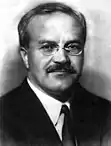 |
۱۹ دسامبر ۱۹۳۰ – ۶ مه ۱۹۴۱ | 1931, 1935, 1936, 1937 | Molotov I | |
| او بر تجمیع کشاورزی استالین و برنامه پنجساله اول صنعتیسازی شوروی و پاکسازی بزرگ ۱۹۳۷–۳۸ نظارت کرد.[8] با وجود هزینههای انسانی، [9] شوروی در دوره رهبری نامی مولوتوف در زمینه کسب فناوریها پیشرفت زیادی کرد.[10] | ||||||
| ۴ | ژوزف استالین (1878–1953)[11] |
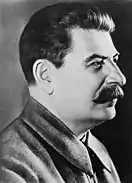 |
۶ مه ۱۹۴۱ – ۱۵ مارس ۱۹۴۶ | 1946 | Stalin I | |
| کشور را در جبهه شرقی (جنگ جهانی دوم) هدایت کرد و دوره نوسازی کشور را شروع کرد. او دفتر کمیسرهای خلق را به شورای وزیران تعییر نام داد.[12] | ||||||
| رئیس شورای وزیران (۱۹۴۶–۱۹۹۱) | ||||||
| ژوزف استالین (1878–1953)[11] |
 |
۱۵ مارس ۱۹۴۶ – ۵ مارس ۱۹۵۳ | 1950 | Stalin II | ||
| After the war, Stalin installed communist governments in most of Eastern Europe, forming the بلوک شرق، [13] behind what was referred to as an "پرده آهنین" of Soviet rule during the long period of antagonism between the Western world and the USSR, known as the جنگ سرد.[14] | ||||||
| ۵ | گئورگی مالنکوف (1902–1988)[15] |
 |
۶ مارس ۱۹۵۳ – ۸ فوریه ۱۹۵۵ | 1954 | Malenkov I–II | |
| Took over after Stalin's death, but lost in the ensuing power struggle against نیکیتا خروشچف. He continued to hold the office of premier until Khrushchev started the process of استالینزدایی. He was replaced on Khrushchev's orders by نیکلای بولگانین.[16] | ||||||
| ۶ | نیکلای بولگانین (1895–1975)[17] |
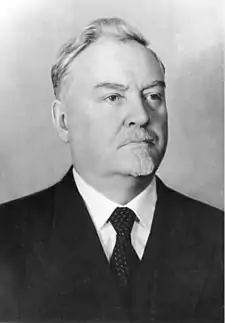 |
۸ فوریه ۱۹۵۵ – ۲۷ مارس ۱۹۵۸ | 1958 | Bulganin I | |
| Oversaw the period of استالینزدایی.[18] While being a strong supporter of Khrushchev at first, he started doubting some of his more radical policies and, accused of being a member of the گروه ضدحزبی، was eventually replaced by Khrushchev himself.[19] | ||||||
| ۷ | نیکیتا خروشچف (1894–1971)[15] |
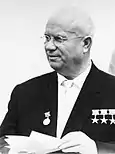 |
۲۷ مارس ۱۹۵۸ – ۱۴ اکتبر ۱۹۶۴ | 1962 | Khrushchev I–II | |
| Led the country through the بحران موشکی کوبا. Oversaw numerous reforms and policy innovations, such as the 1961 monetary reform. His increasingly erratic behaviour led to his removal by the nomenklatura both as premier and First Secretary of the Communist Party.[18] | ||||||
| ۸ | آلکسی کاسیگین (1904–1980)[20] |
 |
۱۵ اکتبر ۱۹۶۴ – ۲۳ اکتبر ۱۹۸۰ | 1966, 1970, 1974, 1979 | Kosygin I–V | |
| Was one of three leading members of the collective leadership with لئونید برژنف and نیکولای پدگورنی. He ruled through the era known as the Era of Stagnation.[21] Kosygin initiated three large scale economic reforms under his leadership; the 1965, the 1973–74 and the 1979 reform.[22] He retired from office in October 1980 and died two months later.[23] | ||||||
| ۹ | نیکولای تیخونوف (1905–1997)[24] |
 |
۲۳ اکتبر ۱۹۸۰ – ۲۷ سپتامبر ۱۹۸۵ | 1984 | Tikhonov I–II | |
| After Kosygin's departure, Tikhonov became the new premier;[25] he held the office through Brezhnev's last years, the rules of یوری آندروپوف and کنستانتین چرنینکو and the very beginning of میخائیل گورباچف's tenure.[26] | ||||||
| ۱۰ | نیکولای ریژکوف (born 1929)[24] |
 |
۲۷ سپتامبر ۱۹۸۵ – ۱۴ ژانویه ۱۹۹۱ | 1989 | Ryzhkov I–II | |
| Ryzhkov supported Gorbachev's attempt to revive and restructure the اقتصاد اتحاد جماهیر شوروی through decentralising planning and introducing new technology. However, he resisted Gorbachev's later attempts to introduce market mechanisms into the Soviet economy.[27] He was forced to resign when his office as Chairman of the Council of Ministers was dissolved.[28] | ||||||
| ۱۱ | Prime Minister of the Soviet Union (1991) | |||||
| والنتین پاولوف (1937–2003)[29] |
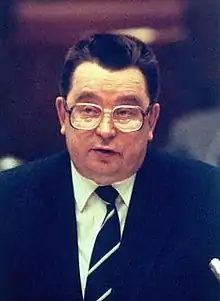 |
۱۴ ژانویه ۱۹۹۱ – ۲۲ اوت ۱۹۹۱ | — | Pavlov I | ||
| Pavlov was elected to the new position of Prime Minister as a compromise candidate. He carried out a highly unsuccessful monetary reform which failed[30] and led him to join the State Committee of the State of Emergency. The State Committee attempted to depose Gorbachev on 19 August. With the collapse of the coup, Pavlov was arrested on 29 August.[31] | ||||||
| ۱۲ | Chairman of the Interstate Economic Committee – Prime Minister of the Economic Commonwealth (1991) | |||||
| Ivan Silayev (born 1930)[32] |
— | ۶ سپتامبر ۱۹۹۱ – ۲۶ دسامبر ۱۹۹۱ | — | Silayev I | ||
| After the August Coup of 1991, the Soviet government lost much of its power over the republics. Silayev was unable, together with Gorbachev, to hold the Soviet state together which eventually led to its demise.[33] | ||||||
منابع
- Cull, Culbert & Welch 2003, p. ۱۸۲.
- Young & Braden 2005, p. ۴۰.
- Service 2000, p. 1.
- Образование СССР (به Russian). Hrono.info. Retrieved 24 September 2010.
- Phillips 2000, p. ۸۲.
- Rappaport 1999, pp. ۲۳۸–۳۹.
- Phillips 2000, p. ۸۹.
- Fainsod & Hough 1979, p. ۲۹۵.
- Sebag-Montefiore 2005, p. ۱۲۵.
- Sebag-Montefiore 2005, p. ۲۳۶.
- Totten & Bartrop 2008, p. ۷۶.
- Service 2005, pp. ۳–۴.
- Service 2005, pp. 3–4.
- Service 2005, p. ۵۰۳.
- Duiker & Spielvogel 2006, p. ۵۷۲.
- Coppa 2006, pp. ۱۷۰–۷۱.
- Trahair & Miller 2004, p. ۶۹.
- Gorbachev, Mikhail (26 April 2007). "The First Steps Towards a New Era". گاردین. Retrieved 4 September 2010.
- Coppa 2006, p. ۳۸.
- Trahair & Miller 2004, p. ۳۷.
- Brown 2009, p. 403.
- ютуба, любитель (17 December 2010). "30 лет назад умер Алексей Косыгин" [A reformer before Yegor Gaidar? Kosygin died for 30 years ago]. Newsland (به Russian). Retrieved 3 January 2011.
- Вергасов, Фатех. Организация здорового накала (به Russian). pseudology.org. Retrieved 4 September 2010.
- Ploss 2010, p. ۲۱۹.
- Zemtsov 1989, p. 119.
- Service 2009, pp. ۴۰۳–۴.
- Garcelon 2005, pp. 128–29.
- Harris 2005, p. ۱۳۳.
- Валентин Сергеевич Павлов [Valentin Sergeyevich Pavlov] (به Russian). RU: Hrono. Retrieved 6 December 2010.
- Dyker 1992, pp. 207–8.
- Bonnell & Cooper 1994, pp. ۶۳–۶۴.
- Иван Степанович Силаев [Ivan Stepanovich Silayev] (به Russian). RU: Hrono. Retrieved 6 December 2010.
- Kotz & Weir 2007, p. ۱۲۲.
- مشارکتکنندگان ویکیپدیا. «Premier of the Soviet Union». در دانشنامهٔ ویکیپدیای انگلیسی، بازبینیشده در ۲۰ آوریل ۲۰۱۸.
پیوند به بیرون
| در ویکیانبار پروندههایی دربارهٔ نخستوزیر اتحاد شوروی موجود است. |
- این اعداد رسمی نیستند.
This article is issued from Wikipedia. The text is licensed under Creative Commons - Attribution - Sharealike. Additional terms may apply for the media files.
